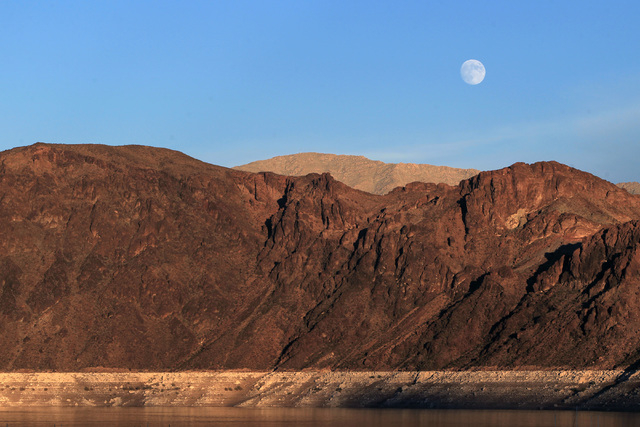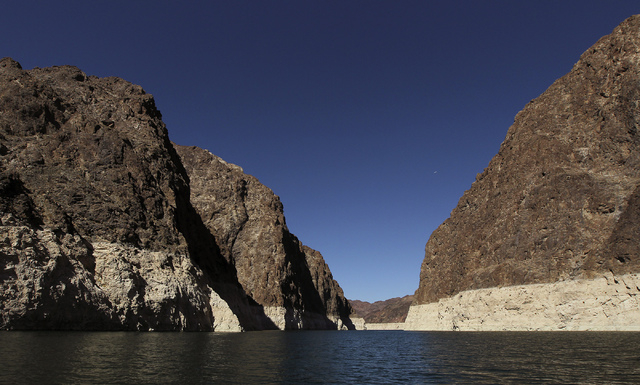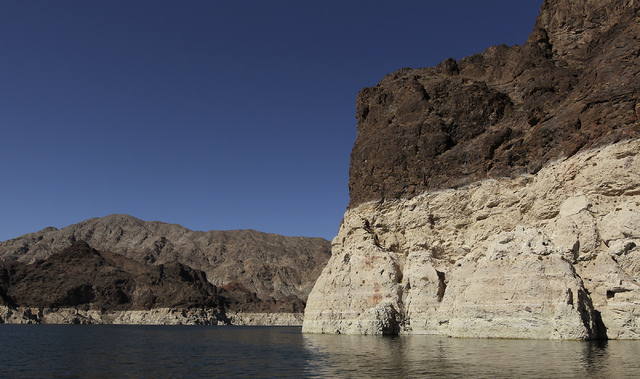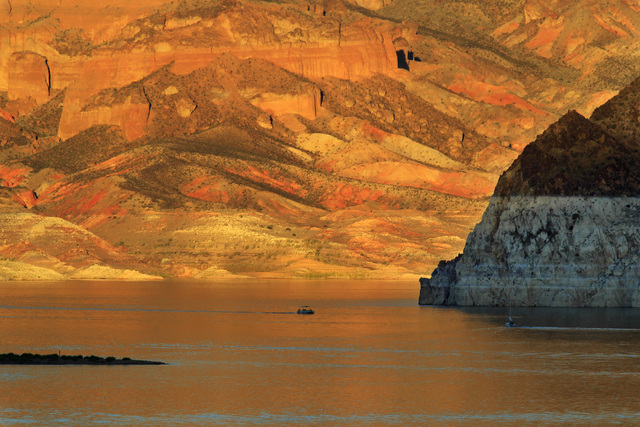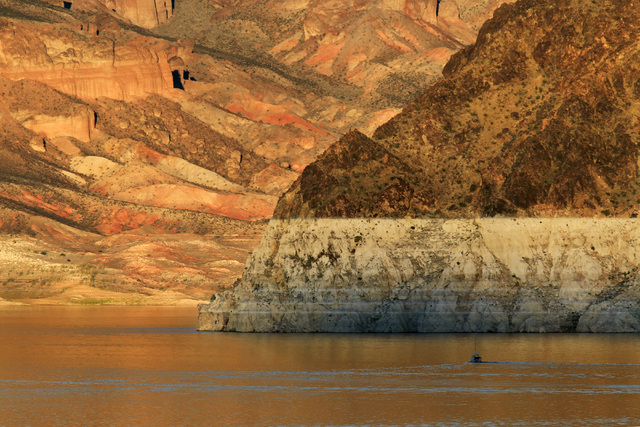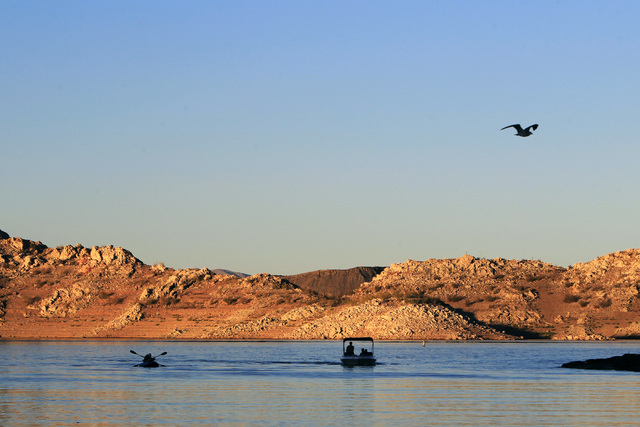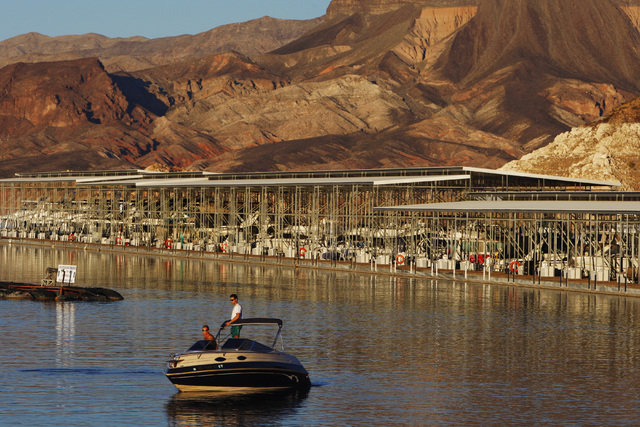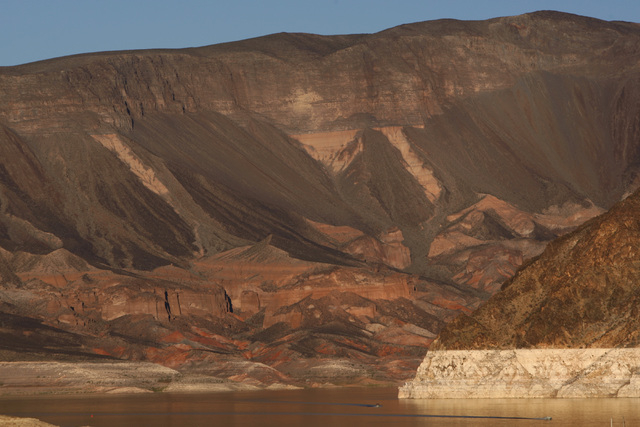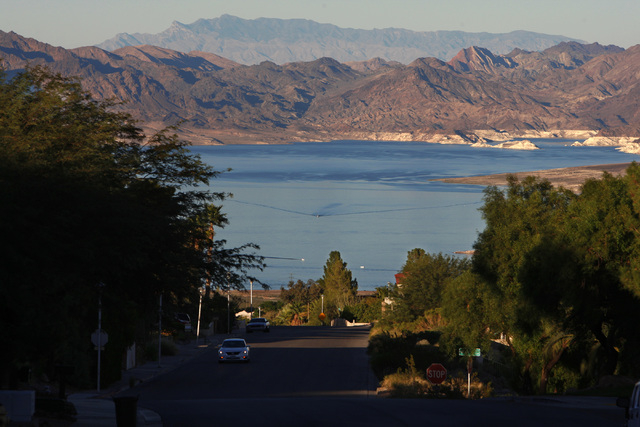Savage drought will drive Lake Mead to record low on Sunday
Sunday’s forecast for Lake Mead calls for breezy conditions, with a high in the low 80s and a water level as low as it has been in 78 years.
The reservoir east of Las Vegas is expected to reach a new record low this weekend and continue downward another 7 feet through June, as the drought-stricken Colorado River withers from its 12th dry year since 2000.
The latest projections by the U.S. Bureau of Reclamation call for the new record to arrive sometime after midnight Sunday, when the surface of Lake Mead dips below the current low-water mark, set on Aug. 13, 2014, of 1,080.19 feet above sea level.
The last time Lake Mead was this low was May 1937, the same month as the Hindenburg explosion. The reservoir then was filling for the first time behind the new Hoover Dam.
The bleak new milestone comes as federal forecasters slash their projections for how much water will make its way into the Colorado River in the coming months, as snow melts away in the mountains of Utah, Colorado and Wyoming.
Last month, the forecast called for the river that supplies water and power to some 40 million people in the U.S. and Mexico to see about 71 percent of its average flow this summer. Now forecasters expected the river’s flow to be more like 52 percent of average, and it could go even lower than that, according to one expert.
Randy Julander supervises the federal snow survey program in Nevada, Utah and California for the U.S. Department of Agriculture. He said this winter was abnormally dry across the West, and bad enough in Utah to rank among the worst “super-drought” years on record.
“What’s going on is we can’t buy a storm in any way, shape or form,” Julander said. “There just isn’t any snowpack to melt. The scientific term is ‘diddly squat.’”
As a result, the Colorado is being squeezed at both ends — dry conditions at the headwaters that reduce its flow and huge demand downstream as California suffers through a historic drought of its own.
Smack in the middle is the Las Vegas Valley, which draws roughly 90 percent of its water from the river using two intake pipes at Lake Mead. A new deep-water intake is expected to go online by the end of summer, and the Southern Nevada Water Authority is rushing to design and build an associated pumping station to keep water flowing to the community even if the reservoir shrinks another 185 feet to “dead pool,” the level at which that Hoover Dam can no longer release water.
Such a scenario was once unthinkable, but now water managers are spending a great deal of money preparing for it. The combined cost of the water authority’s new intake pipe and pump station will likely top $1.4 billion.
And they aren’t the only ones building.
The National Park Service will spend the summer — and as much as $2 million — extending all but one of the lake’s boat launch ramps.
Construction is to start in mid-May and last until July 31. The Park Service plans to keep at least one lane of each ramp open during the work. Updated ramp conditions will be posted at www.nps.gov/lake/learn/news/lakeconditions.htm.
“We are committed to maintaining lake access at all of our open launch ramps,” said Patrick Gubbins, acting superintendent of Lake Mead National Recreation Area.
So far, the declining water level has not impacted visitation at the lake, which consistently ranks as one of the nation’s most-visited Park Service sites. Between 2o13 and 2014, the recreation area saw a 10 percent increase in visitation and a 15 percent increase in the amount of money that visitors spent in and around the park, according to Lake Mead spokeswoman Christie Vanover.
Park Service estimates released this week suggest that last year alone the park and its visitors injected $290 million into the economies of the surrounding communities.
Federal forecasters expect Lake Mead’s gradual decline to continue through the end of June, when the surface could dip as low as 1,073 feet above sea level. After that, the lake should begin to inch back up, adding almost 10 feet by next March, when the forecast calls for it to shrink once more into the realm of the record book.
Contact Henry Brean at hbrean@reviewjournal.com or 702-383-0350. Find him on Twitter: @RefriedBrean.



